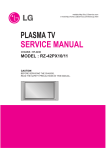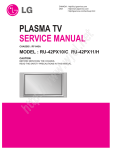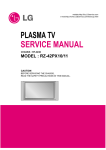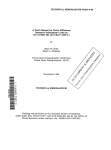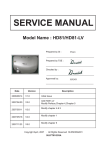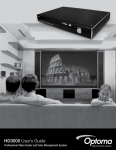Download Zenith RU-42PX20 Service manual
Transcript
http//www.zenithservice.com SERVICE MANUAL Product Type: Chassis: Manual Series: Manual Part #: Model Line: Product Year: Model Series: P42W46X PLASMA RF-043A P42W46XH 2004 CONTENTS Description of Controls .................................................4 Product Specifications ..................................................7 Adjustment Instructions ................................................8 Diagrams ...................................................................23 Parts List ...................................................................27 Schematics .................................................................... Published Oct. 2003 by Technical Publications LG Electronics USA, Inc. 201 James Record Road, Huntsville, Alabama 35824-1513 Copyright © 2003 by Zenith Electronics Corporation Printed in Korea PRODUCT SAFETY GUIDELINES IMPORTANT SAFETY NOTICE This manual was prepared for use only by properly trained audio-visual service technicians. When servicing this product, under no circumstances should the original design be modified or altered without permission from Zenith Electronics Corporation. All components should be replaced only with types identical to those in the original circuit and their physical location, wiring and lead dress must conform to original layout upon completion of repairs. CAUTION: Do not attempt to modify this product in any way. Never perform customized installations without manufacturer’s approval. Unauthorized modifications will not only void the warranty, but may lead to property damage or user injury. Service work should be performed only after you are thoroughly familiar with these safety checks and servicing guidelines. 5. No lead or component should touch a receiving tube or a resistor rated at 1 watt or more. Lead tension around protruding metal surfaces must be avoided. 6. After reassembly of the set, always perform an AC leakage test on all exposed metallic parts of the cabinet (the channel selector knobs, antenna terminals, handle and screws) to be sure that set is safe to operate without danger of electrical shock. DO NOT USE A LINE ISOLATION TRANSFORMER DURING THIS TEST. Use an AC voltmeter having 5000 ohms per volt or more sensitivity in the following manner: Connect a 1500 ohm, 10 watt resistor, paralleled by a .15 mfd 150V AC type capacitor between a known good earth ground water pipe, conduit, etc.) and the exposed metallic parts, one at a time. Measure the AC voltage across the combination of 1500 ohm resistor and .15 mfd capacitor. Reverse the AC plug by using a non-polarized adaptor and repeat AC voltage measurements for each exposed metallic part. Voltage measured must not exceed 0.75 volts RMS. This corresponds to 0.5 milliamp AC. Any value exceeding this limit constitutes a potential shock hazard and must be corrected immediately. TIPS ON PROPER INSTALLATION GRAPHIC SYMBOLS The exclamation point within an equilateral triangle is intended to alert the service personnel to important safety information in the service literature. The lightning flash with arrowhead symbol within an equilateral triangle is intended to alert the service personnel to the presence of noninsulated “dangerous voltage” that may be of sufficient magnitude to constitute a risk of electric shock. A V The pictorial representation of a fuse and its rating within an equilateral triangle is intended to convey to the service personnel the following fuse replacement caution notice: CAUTION: FOR CONTINUED PROTECTION AGAINST RISK OF FIRE, REPLACE ALL FUSES WITH THE SAME TYPE AND RATING AS MARKED NEAR EACH FUSE. SERVICE INFORMATION While servicing, use an isolation transformer for protection from AC line shock. After the original service problem has been corrected, make a check of the following: FIRE AND SHOCK HAZARD 1. Never install any receiver in a closed-in recess, cubbyhole, or closely fitting shelf space over, or close to, a heat duct, or in the path of heated air flow. 2. Avoid conditions of high humidity such as: outdoor patio installations where dew is a factor, near steam radiators where steam leakage is a factor, etc. 3. Avoid placement where draperies may obstruct venting. The customer should also avoid the use of decorative scarves or other coverings that might obstruct ventilation. 4. Wall- and shelf-mounted installations using a commercial mounting kit must follow the factory-approved mounting instructions. A product mounted to a shelf or platform must retain its original feet (or the equivalent thickness in spacers) to provide adequate air flow across the bottom. Bolts or screws used for fasteners must not touch any parts or wiring. Perform leakage tests on customized installations. 5. Caution customers against mounting a product on a sloping shelf or in a tilted position, unless the receiver is properly secured. 6. A product on a roll-about cart should be stable in its mounting to the cart. Caution the customer on the hazards of trying to roll a cart with small casters across thresholds or deep pile carpets. 7. Caution customers against using a cart or stand that has not been listed by Underwriters Laboratories, Inc. for use with its specific model of television receiver or generically approved for use with TVs of the same or larger screen size. 8. Caution customers against using extension cords. Explain that a forest of extensions, sprouting from a single outlet, can lead to disastrous consequences to home and family. 1. Be sure that all components are positioned to avoid a possibility of adjacent component shorts. This is especially important on items transported to and from the repair shop. 2. Verify that all protective devices such as insulators, barriers, covers, shields, strain reliefs, power supply cords, and other hardware have been reinstalled per the original design. Be sure that the safety purpose of the polarized line plug has not been defeated. 3. Soldering must be inspected to discover possible cold solder joints, solder splashes, or sharp solder points. Be certain to remove all loose foreign particles. 4. Check for physical evidence of damage or deterioration to parts and components, for frayed leads or damaged insulation (including the AC cord), and replace if necessary. - 2 - TABLE OF CONTENTS DESCRIPTION OF CONTROLS ...........................................4 SPECIFICATIONS.................................................................7 ADJUSTMENT INSTRUCTIONS ..........................................8 TROUBLE SHOOTING GUIDE ...........................................12 BLOCK DIAGRAM...............................................................23 EXPLODED VIEW...............................................................26 EXPLODED VIEW PARTS LIST .........................................27 REPLACEMENT PARTS LIST ............................................28 SCHEMATIC DIAGRAM.......................................................... PRINTED CIRCUIT BOARD ................................................... - 3 - DESCRIPTION OF CONTROLS Controls - This is a simplified representation of front panel. Here shown may be somewhat different from your TV. - This manual explains the features available on the P42W46X. Front Panel Controls ON/OFF TV/VIDEO ON/OFF Button MENU VOL MENU Button Remote Control Sensor TV/VIDEO Button Power Standby Indicator Illuminates red in standby mode, Illuminates green when the TV is turned on. - 4 - CH CHANNEL (E, VOLUME (F,G) Buttons D) Buttons DESCRIPTION OF CONTROLS Connection Options L / MONO A/V INPUT2 VIDEO S-VIDEO S-VIDEO Input A connection available to provide better picture quality than the video input. VIDEO Input Connects the video signal from a video device. R AUDIO AUDIO Input Use to connect to hear stereo sound from an external device. Monitor Output Connect a second TV or Monitor. DVD/DTV Input (Component 1-2) Connect a component video/audio device to these jacks. S-Video Input Connect S-Video out from an S-VIDEO device to the S-VIDEO input. Remote Control Port Connect your wired remote control here. COMPONENT INPUT 2 MONITOR OUTPUT COMPONENT INPUT 1 REMOTE CONTROL RS-232C INPUT (CONTROL/SERVICE) DVI INPUT AUDIO INPUT A/V INPUT 1 R RGB INPUT VIDEO RGB Input/Audio Input/DVI Input Connect the monitor output connector from a PC to the appropriate input port. If you want to use RGB/DVI audio, we strongly recommend that you use the cable that has a core, or the EMI filter core along with separate cable. L AUDIO R L/MONO AUDIO S-VIDEO Antenna AC INPUT VIDEO Audio/Video Input 1 Connect audio/video output from an external device to these jacks. Antenna Input Connect cable or antenna signals to the TV, either directly or through your cable box. Power Cord Socket This TV operates on AC power. The voltage is indicated on the Specifications page. Never attempt to operate the TV on DC power. RS-232C INPUT (CONTROL/SERVICE) PORT Connect to the RS-232C port on a PC. - 5 - DESCRIPTION OF CONTROLS Remote Control Key Functions - When using the remote control, aim it at the remote control sensor on the TV. MUTE Switches the sound on or off. TVVIDEO Selects: TV, Video 1-2, Component 1-2, RGB, and DVI input sources. MUTE POWER TV/VIDEO MULTIMEDIA MTS CAPTION ARC MENU MULTIMEDIA Selects: Component 1-2, RGB, and DVI input sources. CAPTION Selects CAPTION mode. VOLUME UP/DOWN Increases/decreases the sound level. Selects a menu item. CHANNEL UP/DOWN Selects available channels found with Auto program. Adjusts menu settings.Switches the set on from standby. ENTER Accepts your selection or displays the current mode. FCR Use to scroll the favorite channel list. APC Adjusts the factory preset picture according to the room. PIP/DW Switches between PIP and Double Window modes. SPLIT ZOOM Enlarges the picture with regular ration. POWER Turns your TV on or off. MENU Brings up the main menu to the screen. CH ENTER VOL MTS Selects the MTS sound: Mono, Stereo, or SAP. VOL ARC Changes the picture format. CH 1 2 3 4 5 6 7 8 FCR 9 NUMBER buttons REVIEW Tunes to the last channel viewed. REVIEW 0 APC PIP/DW DASP SPLIT ZOOM PIP CH + SLEEP DASP Selects the sound appropriate for the program's character. SLEEP Sets the sleep timer. WIN.SIZE PIP CH - PIP INPUT POSITION SWAP A.PROG MEMORY/ERASE PIPCH-/PIPCH+ Changes to next lower/higher PIP channel. PIP INPUT Selects the input source for the sub picture. A.PROG (AUTO PROGRAM) Searches for available channels. WIN. SIZE Adjusts the sub picture size. MEMORY/ERASE Memorizes or erases selected channel. POSITION Moves the sub picture in pip mode. SWAP Exchanges the main/sub images. - 6 - SPECIFICATIONS MODEL P42W46X Width (inches / mm) 48.4 / 1210 Height (inches / mm) 27.6 / 701 Depth (inches / mm) 11.4 / 290 Weight (pounds / kg) 66 / 22.9 Resolution 852 x 480 (Dot) Power requirement AC100-240V, 60Hz Television System NTSC Program Coverage VHF 2 ~ 13, UHF 14 ~ 69, CATV 1 ~ 125 External Antenna Impedance 75 Ω Color 16,770,000 (256 steps of each R, G and B) Operating Temperature Range 32 ~ 104°F (0 ~ 40°C) Operating Humidity Range Less than 80% Maximum Elevation 6561 feet (2000m) • The specifications shown above may be changed without notice for quality improvement. - 7 - ADJUSTMENT INSTRUCTIONS (2) After installing the Gprobe, [Option -> Connection Setup] or click the icon indicated in the picture and then setup as below the picture. (In case of the port (second one), set to the serial port of the connected PC. The other only have to be set as below the picture.) (3) After finishing inputs, click the button [OK] to complete the connection setup. 1. Application Object These instructions apply to the RF-043A Chassis. 2. Specification (1) Because this is not a hot chassis, it is not necessary to use an isolation transformer. However, the use of isolation transformer will help protect test instrument. (2) Adjustment must be done in the correct order. (3) The adjustment must be performed in the circumstance of 25±5°C of temperature and 65±10% of relative humidity if there is no specific designation. (4) The input voltage of the receiver must keep 100~220V, 50/60Hz. (5) The receiver must be operated for about 15 minutes prior to the adjustment. 3-2. Confirming the G-prove (1) Connect Rs232 cable and then turn on the power. If communication is correct, the message is showed like in the left output terminal. (2) If the message is not showed, push the [INSTART] button of the adjust remocon twice, and change the right selection of the [System Control -> RS-232 Host] from GProbe to PC. ** If it is impossible to check the OSD, push the [TILT] button of the adjust remocon. Then, the message which is “Starting Gprove...” comes up. From this time, communication is operated correctly. However, you have to push the [TILT] button again in case of turning on Main Power. ** If you want to check again whether commnunication is on or not, input “test” and push the Enter key on the right input terminal. If communication is on, the message of “Test passed.” will come up After RGB Full white HEAT-RUN Mode, the receiver must be operated prior to adjustment. O Enter into HEAT-RUN MODE 1) Press the POWER ON KEY on R/C for adjustment. 2) OSD display and screen display 100% full WHITE PATTERN. O [ Set is activated HEAT-RUN without signal generator in this mode. [ Single color pattern(RED/BLUE/GREEN) of HEAT-RUN mode uses to check PANEL. Caution) If you turn on a still screen more than 20 minutes (Especially digital pattern, cross hatch pattern), a after image may be occur in the black level part of the screen. 3. Channel memory 3-1. Setting up the G-prove (Fig 2) 3-3. Channel memory method (1) Click [Command -> Batch]. (2) When the window of [Batch] is showed, enter the text file (Ch_Memory-RZ_PX10.txt) in the right blank of the File. (3) Click the button [OK] to write CH information in the EEPROM. (4) It means the completion of the CH memory download that the message of right output terminal is showed as below. (Fig 1) (1) Install the GProve. (GProve4.4.0.2.exe) - 8 - ADJUSTMENT INSTRUCTIONS Each PCB assembly must be checked by check JIG set. (Because power PCB Assembly damages to PDP Module, especially be careful) 5. POWER PCB Assy Voltage Adjustments (Va, Vs Voltage Adjustments) 5-1. Test Equipment : D.M.M. 1EA 5-2. Connection Diagram for Measuring Refer to Fig 5. (Fig 3) 4. HDCP download 4-1. Setting up & Confirming the G-prove : Refer to 3-1 and 3-2. 4-2. HDCP download method (1) Click [Command -> NVRAM Write] (2) When the window of [NVRAM Write] is showed, select “LGEKEY1.bin” to insert fill up in the File. (3) LGEKEY1 : first KEY value (4) Address : insert ‘0’ (5) After finishing inputs, click the button [OK] to write HDCP key in the EEPROM. (6) It means the end of the HDCP key download that the message of Output terminal is showed as below. < 3501V00180A > < 3501V00182A > (Fig 5) Connection Diagram of power adjustment for measuring (Fig 4) 5-3. Adjustment Method for P/No. 3501V00180A B/D (1) Va Adjustment 1) After receiving 100% Full White Pattern, HEAT RUN. 2) Connect + terminal of D.M.M to Va pin of P805, connect - terminal to GND pin of P805. 3) After turning RV501, voltage of D.M.M adjustment as same as Va voltage which on lable of panel right/top (Deviation; ±0.5V) (2) Vs Adjustment 1) Connect + terminal of D.M.M to Vs pin of P805, connect – terminal to GND pin of P805. - 9 - ADJUSTMENT INSTRUCTIONS (2) Supply Gray Pattern (216 Level Full Size Pattern) signal to VIDEO input. (AV2 Input 60Hz) (Refer to Fig. 6) (3) To adjust, stick sensor to 216 Gray Level Pattern, press ADJ key twice(White Balance) on remote control. For adjustment and D, E on reomte control for adjustment mode to select Red Gain and Blue Gain, press VOL +, Key and adjust it until color coordination becomes as below. 2) After turning RV401, voltage of D.M.M adjustment as same as Va voltage which on label of panel right/top. (Deviation; ±0.5V) 5-4. Adjustment Method for P/No. 3501V00182A B/D (1) Va Adjustment 1) After receiving 100% Full White Pattern, HEAT RUN. 2) Connect + terminal of D.M.M to Va pin of P805, connect - terminal to GND pin of P805. 3) After turning RV601, voltage of D.M.M adjustment as same as Va voltage which on lable of panel right/top (Deviation; ±0.5V) X; 0.283±0.003, Y; 0.297±0.003 Color Temperature; 9,300°K±500°K (4) Exit adjustment mode using A Key. (2) Vs Adjustment 1) Connect + terminal of D.M.M to Vs pin of P805, connect – terminal to GND pin of P805. 2) After turning RV401, voltage of D.M.M adjustment as same as Va voltage which on label of panel right/top. (Deviation; ±0.5V) 7. Auto RGB Color Balance 7-1. Pattern Equipment PC Pattern Generator (VG828, VG854, 801GF, MSP3240A) (16 Gray Scale Pattrtn output(RGB output Level: 0.7Vp-p) 7-2. Method of Auto RGB Color Balance 6. Adjustment of White Balance (1) Input RGB Source : 16 Gray Scale Pattern output (RGB output Level : 0.7Vp-p) (2) Press ADJ KEY on R/C for adjustment. (3) Press Vol. + KEY and operate To SET. (4) Auto-RGB OK means completed adjustment. 6-1. Required Equipment Color Analyzer (CA-100 or same product) 6-2. Connection Diagram of Equipment for Measuring 8. Auto Component Color Balance 216 Gray Level 8-1. Pattern Equipment AV Signal Input MSP3240A or same product (16 Gray Scale Pattern output(Component output Level: 0.7Vp-p) Full Size Pattern 60Hz Window 8-2. Method of Auto RGB Color Balance RS-232C Serial Communication (1) Input RGB Source : Component 480p/576p 16 Gray Scale Pattern At this time, except Pb and Pr signal, only Y signal insert. (2) Press ADJ KEY on R/C for adjustment. (3) Press Vol. + KEY and operate To set. (4) Auto-RGB OK means completed adjustment. MSPG-2100 or MSTG-5200 (Fig 6) White Balance Adjustment 6-3. Adjustment of White Balance O O Operate the Zero-calibration of the CA-100, then stick sensor to PDP module surface when you adjust. For manual adjustment, it is also possible by the following sequence. (1) Select white pattern of heat-run mode by pressing power on key on remote control for adjustment then operate heat run more than 15 minutes. (Fig 7) Auto RGB/ Component Color Balance Test Pattern - 10 - ADJUSTMENT INSTRUCTIONS 9. Auto Adjustment Map(RS-232C) 6) If Check Sum is not 53, repeat 3) ~ 4). 7) If Check Sum is 53, DDC data for Analog-RGB input is completed. RF-043A Type RS232 (2) DDC Data input for Digital-RGB(DVI) Baud Rate Data bit Stop bit Parity 115200 8 1 NONE Index Cmd1 Cmd2 Data Min Value Max Value R Gain j a 00(00) 255(FF) G Gain j b 00(00) 255(FF) Protocol B Gain Setting R Offset j c 00(00) 255(FF) j d 00(00) 255(FF) G Offset j e 00(00) 255(FF) B Offset j f 00(00) 255(FF) 10. DDC Data Input 10-1. Required Test Equipment (1) A jig for adjusting PC, DDC (PC serial to D-sub Connection equipment) (2) S/W for writing DDC (EDID Data Write & Read) (3) D-sub 15P Cable, D-Sub to DVI Connector (Connect to DVI Jack) 10-2. Setting of Device 10-3. Preparation for Adjustment (1) Set devices as above and turn the PC, jig on. (2) Put S/W for writing DDC (EDID data Write & Read) into operation. (operated in DOS mode.) 10-4. Sequence of Adjustment (1) DDC Data Input for Analog-RGB 1) Put the set on the table and turn the power on. 2) Connect PC Serial to D-sub 15P Cable of jig for DDC adjustment to RGB terminal (D-Sub 15Pin). 3) Operate S/W for DDC record and select DDC data for Analog RGB in Model Menu. 4) Operate EDID Write command. 5) Operate EDID Read command and check whether Check Sum is 53. - 11 - 1) Connect PC Serial to DVI Cable of jig for DDC adjustment to DVI terminal (DVI Jack). 2) Operate S/W for DDC record and select DDC data for digital RGB in model menu. 3) Operate EDID Write command. 4) Operate EDID Read command and check whether Check sum is D2(1page), BF(2page). 5) If Check sum is not D2(1page), BF(2page), repeat 3) ~ 4). 6) If Check sum is D2(1page), BF(2page), DDC data for Analog-RGB input is completed. TROUBLE SHOOTING GUIDE 1. Power Board 1-1. The whole flowchart which it follows in voltage output state Start check Doesn't the screen whole come out? Yes It is identical with Power Off condition? No Is the Interface signal operated? Yes No Doesn't the low pressure output come out? Yes 1. Check the Power Off condition. Yes Doesn't the St-by 5V signal come out? 2. Check the Interface signal condition. Doesn't the 5V Monitor signal come out? No Yes No Doesn't the high tension output come out? Yes 3. Check the St-by 5V signal circuit. Yes Doesn't the VSC signal Vs-ON come out? High tension output voltage Drop it occurs? Yes 5. Check the VSC RL-ON signal. Doesn't the Vs, Va voltage output come out? No Doesn't the VSC low pressure output come out? Yes 7. Check the VSC Vs-ON signal When remove the Y, Z B/D Module Input Connector, Power Board high tension output voltage Drop it occurs? Yes 4. Check the 5V Monitor signal circuit. Yes No Doesn't the VSC signal RL-ON come out? No Yes 8. Check the Vs, Va voltage output circuit. No No When remove the Y B/D Module Input Connector, output voltage Drop it occurs? 6. Check the VSC low pressure output No When remove the Z B/D Module Input Connector, output voltage Drop it occurs? No Yes Manufacture enterprise meaning of a passage Yes 10. Check the Z B/D Module Coutput circuit 9. Check the Power Board Output high tension circuit - 12 - Yes 11. Check the Y B/D Module Coutput circuit TROUBLE SHOOTING GUIDE 1-2. Sony Power Board Structure T502: Vs Trans T702: Va Trans 1 2 3 T101: St-by Trans T103: Low Voltage Trans - 13 - TROUBLE SHOOTING GUIDE 1-3. Sanken Power Board Structure T221: Vs Trans T271: Va Trans 1 2 3 T121: St-by Trans T201: Low Voltage Trans - 14 - TROUBLE SHOOTING GUIDE 2. No Power (1) Symptom ¯ ¯ Does’t minute discharge at module. Non does not come in into the front LED. (2) Check follow No Is plug in power cord? Plug in power cord. Yes Is connect the Line Filter and Power Switch Cable? No Connect Cable. Yes Is connect the Power Switch and Power Board Cable? No Connect Cable. Yes Is normal the Fuse(F101) on Power Board? No Replace Fuse. Yes Is connect the Power Board and 7P of VSC Board Cable? No Connect Cable. Yes Is connect the Power Switch and Power Board Cable? No Connect Cable. Yes After remove the cable connect to Power Board(except the CN101 connection cable), authorizes the AC voltage marking on manual. When ST-BY 5V does not operate, replace Power Board. - 15 - TROUBLE SHOOTING GUIDE 3. Protect Mode (1) Symptom After once shining, it does not discharge minutely from module ¯ The Rely falls(The sound is audible “click”) ¯ It is converted with the color where the front LED is red from green. ¯ (2) Check follow Is normal the Power Board? No Is output the normality Low/High voltage except Stand-by 5V? No Replace Power Board. Yes Is normal the each connector? No After connecting well each connector, the normality it operates? No Replace connector. Yes Is normal the Y- Board? No Is normal the Fuse(F52) on Y-B/D? (In case of open is replace) Yes Is normal the output voltage after remove P5, P6 connector of Y-B/D? Yes Replace Y-Board. Yes Replace Z-Board. Yes Is normal the Z- Board? No Is normal the Fuse(FS1, FS2) on ZB/D? (In case of open is replace) Yes Is normal the output voltage after remove P1 connector of Z-B/D? Yes Is normal the X- Board? No Is normal the output voltage after remove P1, 2, 3, 4, 6, 7 connector of X-B/D? Yes No Is normal the output voltage after remove P1, 2, 101, 300, 701, 702 connector of Ctrl-B/D? Yes After remove P1, P2, P3, P4 output voltage normality: Replace Right X-B/D After remove P6, P7 output voltage normality: Replace Left X-B/D Yes Is normal the Ctrl Board? Replace X-Board. Yes Is normal the VSC Board? No Is normal the output voltage after remove P1000, P1200? Yes After remove P1000 normal operation: Replace Analog Board After remove P1200 normal operation: Replace Digital Board Yes Is normal the COF of X, Y, Z? No After crisis COF of each board, check the normality operates. If in case normality operates, correspondence COF Fail is replace the module. - 16 - TROUBLE SHOOTING GUIDE 4. No Raster (1) Symptom ¯ ¯ Does’t minute discharge at module. It maintains the condition where the front LED is green. (2) Check follow Is normal the Power Board? No Is output the normality Low/High voltage except Stand-by 5V? No Replace Power Board. Yes Is normal the each connector? No After connecting well each connector, the normality it operates? No Replace connector. Yes Is normal the Y- Board? No Is normal the Fuse(F52) on Y-B/D? (In case of open is replace) Yes Is normal the output voltage after remove P5, P6 connector of Y-B/D? Yes Replace Y-Board. Yes Replace Z-Board. Yes Is normal the Z- Board? No Is normal the Fuse(FS1, FS2) on ZB/D? (In case of open is replace) Yes Is normal the output voltage after remove P1 connector of Z-B/D? Yes Is normal the X- Board? No Is normal the output voltage after remove P1, 2, 3, 4, 6, 7 connector of X-B/D? Yes No Is normal the output voltage after remove P1, 2, 101, 300, 701, 702 connector of Ctrl-B/D? Yes After remove P1, P2, P3, P4 output voltage normality: Replace Right X-B/D After remove P6, P7 output voltage normality: Replace Left X-B/D Yes Is normal the Ctrl Board? Replace X-Board. Yes Is normal the VSC Board? No Is normal the output voltage after remove P1000, P1200? Yes After remove P1000 normal operation: Replace Analog Board After remove P1200 normal operation: Replace Digital Board Yes Is normal the COF of X, Y, Z? No After crisis COF of each board, check the normality operates. If in case normality operates, correspondence COF Fail is replace the module. - 17 - TROUBLE SHOOTING GUIDE 5. In case of occur strange screen into specific mode 5-1. In case of does’t display the OSD (1) Symptom ¯ ¯ LED is green The minute discharge continuously becomes accomplished from module (2) Check follow Is normal the LVDS cable? No Yes Is the LVDS cable connected well? Replace cable. No Cable inserts well. Yes Is normal the VSC Digital Board? No Operates the Thine Yes IC(IC1100)? Operates the IEP(IC500)? No Replace Thine IC(IC1100). Yes Is normal the Ctrl Board of Module? No Replace IEP(IC500). No Replace Ctrl B/D. - 18 - Yes Operates the Scaler(IC700)? No Replace Scaler(IC700). Yes Replace VSC Digital B/D. TROUBLE SHOOTING GUIDE 5-2. In case of does’t display the screen into specific mode (1) Symptom ¯ The screen does not become the display from specific input mode (RF, AV, Component, RGB, DVI). (2) Check follow ¯ ¯ Check the all input mode should become normality display. Check the Video(Main)/Data(Sub), Video(Main)/Video(Sub) should become normality display from the PIP mode or DW mode. (Re-Check it Swap) (3) In case of becomes unusual display from RF mode No Is normal the Tuner? Is the Tuner Cable connected well? Yes Is normal the Input voltage, IIC Communication and CVBS output? No No Yes Cable inserts well. Is normal the CXA2069Q? No Replace Tuner Is normal the Input voltage, IIC Communication and HV sync? No Is normal the Input voltage, IIC Communication and HV sync? No Replace IC Yes Is normal the VPC3230? No Replace IC (4) In the case of becomes unusual display from RF, AV mode Is normal the CXA2069Q? No Is normal the Input voltage, IIC Communication and HV sync? No Is normal the Input voltage, IIC Communication and HV sync? No Replace IC Yes Is normal the VPC3230? No - 19 - Replace IC TROUBLE SHOOTING GUIDE (5) In the case of becomes unusual display from RF, AV, Component 480i mode Is normal the VPC3230? No Is normal the Input voltage, IIC Communication and HV sync? No Is normal the Input voltage, IIC Communication and HV sync? No Is normal the Input voltage, IIC Communication and HV sync? No Replace IC Yes No Is normal the S2300? Replace IC Yes No Is normal the Scaler? Replace IC (6) In the case of becomes unusual display from Component DTV mode Is normal the 74LS123? No Is normal the Input voltage, IIC Communication and HV sync? No Is normal the Input voltage, IIC Communication and HV sync? No Is normal the Input voltage, IIC Communication and HV sync? No Is normal the Input voltage, IIC Communication and HV sync? No Replace IC Yes Is normal the CXA2101? No Replace IC Yes Is normal the M52758? No Replace IC Yes No Is normal the Scaler? - 20 - Replace IC TROUBLE SHOOTING GUIDE (7) In the case of becomes unusual display from RGB DTV mode Is normal the CXA2101? No Is normal the Input voltage, IIC Communication and HV sync? No Is normal the Input voltage, IIC Communication and HV sync? No Is normal the Input voltage, IIC Communication and HV sync? No Replace IC Yes Is normal the M52758? No Replace IC Yes No Is normal the Scaler? Replace IC (8) In the case of becomes unusual display from RGB PC mode Is normal the M52758? No Is normal the Input voltage, IIC Communication and HV sync? No Is normal the Input voltage, IIC Communication and HV sync? No Replace IC Yes No Is normal the Scaler? Replace IC (8) In the case of becomes unusual display from DVI mode No Is normal the Scaler? Is normal the Input voltage, IIC Communication and HV sync? - 21 - No Replace IC TROUBLE SHOOTING GUIDE 6. In case of no sound (1) Symptom ¯ ¯ LED is green Screen display but sound is not output (2) Check follow Is normal the SPK cable? No Is the SPK cable connected well? Yes Replace SPK cable No Yes Is normal the RGB/DVI sound? Cable inserts well. No Is the Flat cable connected well? Yes No No Cable inserts well. Yes Yes Operates the IC800? Replace IC800 Operates the IC801? No Replace IC801 Yes Is normal the RF/AV/Component sound? No Replace VSC Analog B/D Operates the IC802? No Replace IC802 - 22 - - 23 - 24LC21 RX/ TXC 24LC21 74HCT08 Co mp _Y YCin4 Vin4 TU_Sub TU_Main Text _V Main_YC HYV641620 SRAM SDA6001 Text Processor VPC3230 (S) Video Decoder VPC3230 (M ) Video Decoder Sid e - AV BOARD Co mp _480i CVBS S-VHS Vin5 YCin5 CXA2069Q SWITCH Main_V Main_YC Main_V M52758F Sw it c h RGB_Dat a AM29LV160 F-ROM HY57V64322 SDRAM ( 8MB) YCb Cr S2300 / DeInt erlac er 8 DVI_Dat a g m 1601 Sc aler ( Malib u) ADC w/ PLL 10 24 ZHINE Po s-t p ro c es sing Blo c k is o m it t ed . so-c alled JEPICO, in this c ase TMDS TX is also req uired . So und Pro c es sing Blo c k Diag ram is sep arat ed . . RCA-t yp e Blo c k Diag ram is also sep arat ed . . AM29LV F-ROM (1MB ) IEP TX0/ 1/ 2/ 3/ C Disp _En SDATA SCLK, SLE 24 Co mp _480I/ P Co mp / RGB_SW HY5DU283222A SDRAM ( 128MB) DVI RX w/ HDCP RS232_RX/ TX TX_Out Main_Vid eo / 24 Sub _Vid eo / Co mp / RGB_SW 8 Fro m Malib u CXA_RGB Vid eo f o r Text CXA2101 Text Comp DTV RGB DTV RGB PC Co mp _480I/ P To Malib u 74LS123 Tuner ( S ) Tuner (M) Vin3 (CVBS ) MNT OUT Vin2 ( CVBS ) 1H RGB TV OUT Vin1 ( CVBS) SCL/ SDA RX/ TX0/ 1/ 2, SCL/ SDA RGB H/ V Analo g BOARD Comp1 (DVD/DTV ) S-VHS CVBS RF Scart 3 Scart 2 Scart 1 ST3232C 74ACT253 RGB PC/ DTV RX0/1,TX0/1 Dig it al BOARD DVI (PC/DTV) RGB (PC/DTV) RS232 WIRE IR TX IR BLOCK DIAGRAM IIS RGB DTV IIS HV IIS Tx - 24 - Sid e S-VHS Side-CVBS Sid e A/ V RF S-VHS CVBS OUT CVBS IN ( DVD/ DTV) Co m p 2 ( DVD/ DT V) Co m p 1 24LC21 24LC21 Y/ CIN2 VIN2 Tuner ( S) CXA2069Q 74HCT08 ST3232C 74ACT253 Tuner ( M) Y/ CIN1 MNT_OUT VIN1 Co mp 2 Co mp Analo g BOARD DVI ( PC/ DTV) RGB ( PC/ DTV) RS232 WIRE IR Di gt a l BOARD MAIN_YOUT MAIN_VOUT MAIN_COUT CAB_VIN DTV2_Co mp DAC_RGB RGB_DTV M52758FP IC202( MUX) LA7151M DVD2_MAIN DVD_MAIN DTV_Co mp M52758FP IC204 CXA2101 RGB PC SUB_COUT SUB_YOUT DVD2_SUB DVD_SUB ALT_Y2_480I_SUB VPC3230 ( SUB) COMB_COUT SW CVBS/ Y ALT_Y_480I_SUB UPD64083 COMB_YOUT MAIN_YOUT ALT_Y2_480I_MAIN M62320FP ( I2C Exp end er) HY57V64322 SDRAM ( 8MB) Flash ROM 512K/ 1M TQFP 128K DDR Memo ry M656 8 Bit FLI2300 S656 8 Bit VPC3230 ( MAIN) S/ DVD_Co mp CAB_Co mb RGB_24Bit SVPORT ( 16b it) g m1501H ALT_Y_480I_MAIN M52758FP IC400( MUX) M37136 ( OTP) VPORT ( 24b it) DVI Analo g RGB TMDS Transf er / Thine LVDS 31PIN ZHINE IEP BLOCK DIAGRAM NOTES - 25 - EXPLODED VIEW 300 121 600 601 301 305 304 120 303 302 200 207 202 206 205 530 201 490 204 531 402 580 203 560 410









































